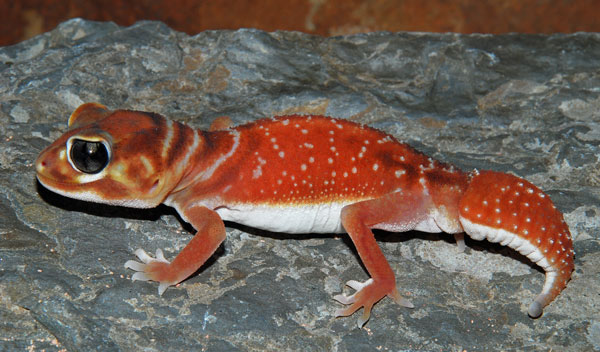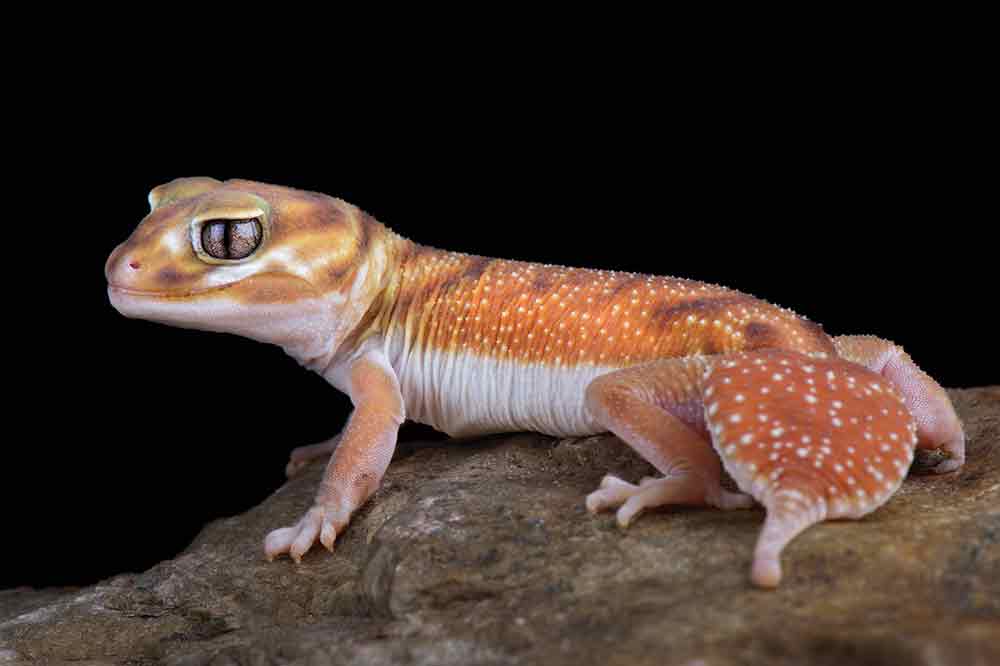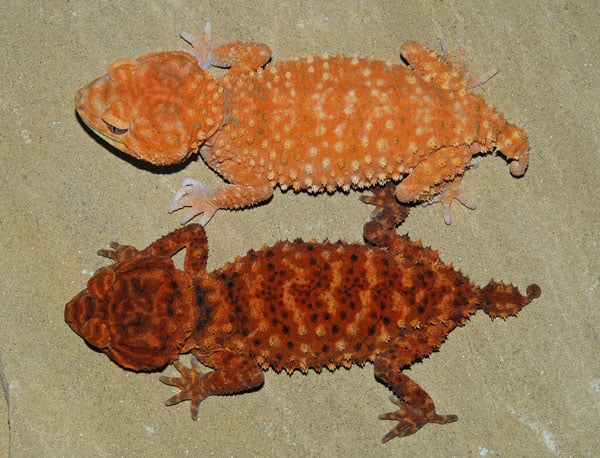Care sheet for the knob-tailed gecko (Nephrurus species).
Updated February 14, 2023
Knob-Tailed Geckos ( Nephrurus species)
Knob-tailed geckos are rapidly gaining popularity among reptilekeepers around the world. Native to Australia, these distinctive geckos are named for the small knob at the tip of their tail, and they’re known for their rasping bark. There are 14 species and subspecies of knob-tailed geckos, and most are available in the reptile trade. Eleven species are in the Nephrurus genus, with two of those species broken down into subspecies. N. levis has three subspecies, and N. wheeleri has two subspecies.
Knob-Tailed Gecko Availability
Several species and subspecies of knob-tailed geckos (namely Nephrurus amyae, N. wheeleri, N. levis and N. milii) have been in captivity for years, and they can regularly be found from gecko breeders specializing in these species. Knob-tailed geckos are rarely, if ever, found in common pet stores; however, certain reptile specialty shops may carry some Nephrurus species on occasion. Prices vary from $150 to $250 for the more common species to thousands of dollars for rarer species.
Knob-Tailed Gecko Size
Knob-tailed geckos are measured based on their snout-to-vent length. Smaller species of knob-tailed geckos, including Nephrurus wheeleri, N. levis and N. deleani, have a SVL of approximately 4 inches. The largest of the knob-tailed geckos, Nephrurus amyae, has a SVL of approximately 5 to 5.5 inches.Tail sizes also vary among knob-tailed gecko species. Nephrurus amyae has a relatively short, narrow tail, but N. levis and N. wheeleri have longer, broader tails.

Nephrurus levis knob-tailed gecko. Photo Credit: Steve Sykes
Knob-Tailed Gecko Life Span
How long a knob-tailed gecko can be expected to live in captivity is currently unknown, mostly due to the relatively short amount of time this species has been within the reptile trade. Although these geckos don’t appear to have as long of a life span as other geckos, such as the leopard gecko, knob-tailed geckos have been known to live past 10 years of age.
Knob-Tailed Gecko Enclosure
Knob-tailed geckos are best kept individually. A 10-gallon equivalent terrarium appropriately houses one adult knob-tailed gecko of any species. However, because many keepers of knob-tailed geckos intend to breed their animals, commercial rack systems are commonly used. My wife, Debra, and I use plastic boxes 16.5 inches long, 10.5 inches wide and 6 inches tall in rack systems.

Knob-tailed gecko Photo by reptiles4all/Shutterstock
Baby knob-tailed geckos should also be housed individually. We house babies in plastic boxes 14 inches long, 7.5 inches wide and 4.5 inches tall.
One to two hide boxes should also be included within the cage to provide shelter and security for the gecko. Hide boxes should err on the small and dark side rather than the large and open side, and they should have only one entrance-exit hole. We use 8-inch-diameter plant saucers for adults and 6-inch saucers for hatchlings.
Knob-Tailed Gecko Lighting and Temperature
Knob-tailed geckos are nocturnal, so they do not need overhead lighting or basking lights. In fact, this type of lighting can stress the gecko.
Heating is best applied by a heating element. An undertank heater works well with an aquarium or terrarium. Flexwatt heat tape or heat cables work well with rack systems. Place the heating element on one side of the cage, so a temperature gradient results. The hot side should be kept around 87 to 89 degrees Fahrenheit.
Knob-Tailed Gecko Substrate
A fine-grain sand is the best substrate option for knob-tailed geckos. Some species, especially Nephrurus levis and N. deleani, are known for digging, and they create small burrows and tunnels in their substrate. Slightly moist sand within the cage provides the right conditions for these knob-tailed geckos to dig their burrows. Other species, such as N. wheeleri and N. amyae, create enclosed environments inside their hide boxes by plugging up the entrance with moist sand.
Knob-Tailed Gecko Food
In the wild, knob-tailed geckos eat a highly varied diet of ants, spiders, cockroaches, crickets, scorpions, caterpillars, beetles, and even smaller geckos and skinks. Most keepers feed their captive knob-tailed geckos crickets or cockroaches four to five times a week. Some keepers have also fed mealworms with success. However, knob-tailed geckos cue in on the movement of prey items, and mealworms are not as visually stimulating as some insects, so they might not induce a feeding response.
Before being fed to hungry geckos, all prey items should be gut-loaded with fresh vegetables or a commercial gut load in order to provide the most nutrients. Furthermore, it is important to dust feeder insects with a vitamin-mineral supplement containing calcium and vitamin D3 right before feeding time.
Knob-Tailed Gecko Water
Water dishes are not necessary for a knob-tailed gecko’s cage, but water is an important requirement. Spraying the cage twice a week is the best way to give a gecko the proper amount of water.
How you water your knob-tailed gecko depends on what species you have. For rough-skinned species, such as Nephrurus amyae and N. wheeleri, spraying the top of the hide box with enough water to last for one to two days is appropriate. These knob-tailed geckos prefer a slightly drier environment, and they don’t require humidity. They lick water from the sides of the cage or hide box, or they absorb water through their skin.
For smooth-skinned species, including Nephrurus levis, N. l. pilbarensis and N. deleani, a more humid environment is preferred. The best way to create more humidity is to directly spray the sand underneath (or inside) the hide box. Humidity will be contained within the hide box and provide enough moisture to render additional misting on top of the hide box unnecessary. Moist sand also provides the appropriate substrate for digging burrows, which is further discussed under the substrate section of this care sheet.
Knob-Tailed Gecko Handling and Temperament
Knob-tailed geckos are tolerant of handling, but they are not as tolerant as other gecko species, such as leopard geckos or crested geckos. Allowing a knob-tailed gecko to walk from hand to hand for short periods of time is OK, but it is not recommended to keep the gecko from its cage for prolonged periods of time. Some species, such as Nephrurus levis and N. wheeleri, might drop their tails if they’re really stressed, but they will regrow them. Other species, such as N. amyae, cannot drop their tails. When they feel threatened, they often growl and bark in order to defend themselves. Although it is fun to handle your pets, knob-tailed geckos are best viewed from the other side of the glass.
Steve Sykes is the source for Knob-Tailed Gecko information and breeding. Please visit his site at www.GeckosEtc.com .


